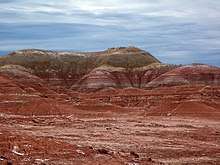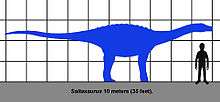Allen Formation
| Allen Formation Stratigraphic range: Mid Campanian-Maastrichtian ~77–69 Ma | |
|---|---|
 Outcrop of the Allen and Anacleto Formations at Auca Mahuida | |
| Type | Geological formation |
| Unit of | Malargüe Group |
| Underlies | Jagüel Formation |
| Overlies | Anacleto Formation |
| Thickness | up to 70 m (230 ft) |
| Lithology | |
| Primary | Mudstone, sandstone |
| Other | Limestone |
| Location | |
| Coordinates | 40°00′S 66°36′W / 40.0°S 66.6°WCoordinates: 40°00′S 66°36′W / 40.0°S 66.6°W |
| Approximate paleocoordinates | 42°48′S 52°12′W / 42.8°S 52.2°W |
| Region | Neuquén, Río Negro & La Pampa Provinces |
| Country |
|
| Extent | Neuquén Basin |
| Type section | |
| Named by | Uliana & Dellapé |
| Year defined | 1981 |
The Allen Formation is a geological formation in Argentina whose strata date back to the Late Cretaceous (middle Campanian to early Maastrichtian.[1] Dinosaur remains are among the fossils that have been recovered from the formation.[2]
Description
The stratotype of the formation was defined by Uliana and Dellapé in 1981 in the eastern area of the Bajo de Añelo, where the relation between base and top is clearly exposed. The deposits are mostly clastic, interbedded with banks of limestone and layers of anhydrite, which were defined continental and shallow marine facies associated with semiarid conditions.[3]
The interpreted sedimentary paleoenvironments range from purely continental such as ephemeral lacustrine, aeolian and fluvial systems to coastal marine paleoenvironments with development of estuaries and tidal flats, followed by a lagoon sedimentary stage from marsh to sea with carbonate precipitation in an area protected from waves, ending with a retraction leading to the accumulation of evaporites.[3]
A detailed facies analysis of the formation was performed by Armas and Sánchez in 2015, where the authors concluded the formation represents a hybrid coastal system of tidal flats, dominated by Atlantic ingressions, with a large storm influence in some areas linked to aeolian systems.[4]
Vertebrate paleofauna
Dinosaurs
Dinosaur eggs are known from the formation.[5]
| Dinosaurs reported from the Allen Formation | ||||||
|---|---|---|---|---|---|---|
| Genus | Species | Location | Stratigraphic position | Material | Notes | Images |
|
Indeterminate[5] |
||||||
|
A. cabazai |
Saltasaurus egg | |||||
|
Lamarqueavis[6] |
L. australis[6] |
"Right coracoid with damaged sternal and omal extremities, and lacking acrocoracoidal process."[6] |
||||
|
L. cholinoi[7] |
Elements of the axial and appendicular skeleton of a subadult individual.[7] |
|||||
|
L. araukanicus[5] |
||||||
|
L. patagonica[5] |
"Partial forelimb."[8] |
|||||
|
P. schroederi[5] |
"Five tail vertebrata, sacral vertebrae, left humerus and rib fragments."[9] |
|||||
|
P. powelli[5] |
"Dorsal and caudal vertebrae, partial femur."[9] |
|||||
|
Q. curriei[5] |
Femur and distal tibia.[10] |
|||||
|
R. muniozi[5] |
"Partial postcranial skeleton."[11] |
|||||
|
S. loricatus[5] |
||||||
|
W. salitralensis[12] |
||||||
Pterosaurs
Fragmentary fossils are known from the formation.[5]
| Pterosaurs reported from the Allen Formation | ||||||
|---|---|---|---|---|---|---|
| Genus | Species | Location | Stratigraphic position | Material | Notes | Images |
|
A. sudamericanus[13] |
Bajo de Arriagada | Uppermost Allen Form. | Partial rostrum | The first unambiguous azhdarchid from South-America. | ||
Mammals
The mammal fauna of the Allen Formation is known from seven teeth, which document the presence of several species.[14]
| Mammals reported from the Allen Formation | ||||||
|---|---|---|---|---|---|---|
| Genus | Species | Location | Stratigraphic position | Material | Notes | Images |
| Mesungulatum | M. lamarquensis | Cerro Tortuga | Two upper molars and a fragmentary lower molar | A dryolestoid | ||
| Groebertherium | G. stipanicici | Cerro Tortuga | One upper molar | A dryolestoid | ||
| Cf. Brandonia | sp. | Cerro Tortuga | One lower molar | A dryolestoid | ||
| Barberenia | B. allenensis | Cerro Tortuga | One upper molariform | A dryolestoid | ||
| Trapalcotherium | T. matuastensis | Cerro Tortuga | One first lower molar | A gondwanathere | ||
See also
References
- ↑ Salgado, L., Coria, R. A., Magalheas Ribeiro, C. M., Garrido, A., Rogers, R., Simon, M. E., Arcucci, A. B., Rogers, K. C., Carabajal, A. P., Apesteguia, S., Fernandez, M., Garcia, R. A., and Talevi, M. (2007). Upper Cretaceous dinosaur nesting sites of Rio Negro (Salitral Ojo de Agua and Salinas de Trapalco-Salitral de Santa Rosa), northern Patagonia, Argentina. Cretaceous Research, 28(3):392–404.
- ↑ Weishampel, David B; et al. (2004). "Dinosaur distribution (Late Cretaceous, South America)." In: Weishampel, David B.; Dodson, Peter; and Osmólska, Halszka (eds.): The Dinosauria, 2nd, Berkeley: University of California Press. Pp. 600-604. ISBN 0-520-24209-2.
- 1 2 Armas & Sánchez, 2015, p.101
- ↑ Armas & Sánchez, 2015, p.110
- 1 2 3 4 5 6 7 8 9 10 11 12 13 14 15 16 17 18 "63.10 Provincia de Rio Negro, Argentina; 5. Allen Formation," in Weishampel, et al. (2004). Page 604.
- 1 2 3 Federico L. Agnolin (2010). "An avian coracoid from the Upper Cretaceous of Patagonia, Argentina". Stvdia Geologica Salmanticensia. 46 (2): 99–119.
- 1 2 3 Rodolfo A. Coria; Bernardo González Riga; Silvio Casadío (2012). "Un nuevo hadrosáurido (Dinosauria, Ornithopoda) de la Formación Allen, provincia de La Pampa, Argentina". Ameghiniana. in press.
- ↑ "Table 11.1," in Weishampel, et al. (2004). Page 215.
- 1 2 "Table 13.1," in Weishampel, et al. (2004). Page 269.
- ↑ "Table 4.1," in Weishampel, et al. (2004). Page 77.
- ↑ "Table 13.1," in Weishampel, et al. (2004). Page 270.
- 1 2 Rubén D. Juárez Valieri; José A. Haro; Lucas E. Fiorelli; Jorge O. Calvo (2010). "A new hadrosauroid (Dinosauria: Ornithopoda) from the Allen Formation (Late Cretaceous) of Patagonia, Argentina" (PDF). Revista del Museo Argentino de Ciencias Naturales n.s. 11 (2): 217–231. Archived from the original (PDF) on 2011-09-03. Retrieved 2011-05-12.
- 1 2 Novas, F. E.; Kundrat, M.; Agnolín, F. L.; Ezcurra, M. N. D.; Ahlberg, P. E.; Isasi, M. P.; Arriagada, A.; Chafrat, P. (2012). "A new large pterosaur from the Late Cretaceous of Patagonia". Journal of Vertebrate Paleontology. 32 (6): 1447. doi:10.1080/02724634.2012.703979.
- ↑ Rougier, G.W., Chornogubsky, L., Casadio, S., Paéz Arango, N. and Giallombardo, A. 2009. Mammals from the Allen Formation, Late Cretaceous, Argentina (subscription required). Cretaceous Research 30:223–238.
Bibliography
- Armas, Paula, and María Lidia Sánchez. 2015. Hybrid coastal edges in the Neuquén Basin (Allen Formation, Upper Cretaceous, Argentina). Andean Geology 42. 97-113. Accessed 2018-10-02.
- Weishampel, David B.; Dodson, Peter; and Osmólska, Halszka (eds.): The Dinosauria, 2nd, Berkeley: University of California Press. 861 pp. ISBN 0-520-24209-2.
Further reading
| Wikimedia Commons has media related to Allen Formation. |
